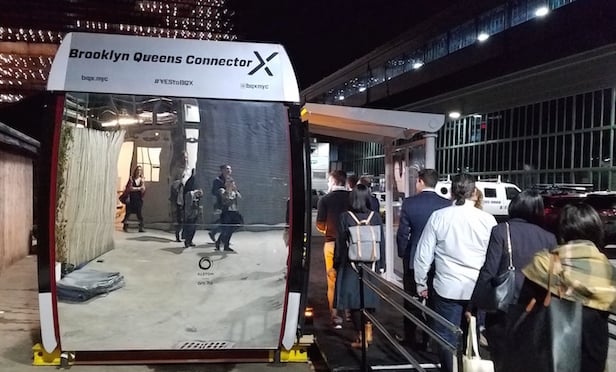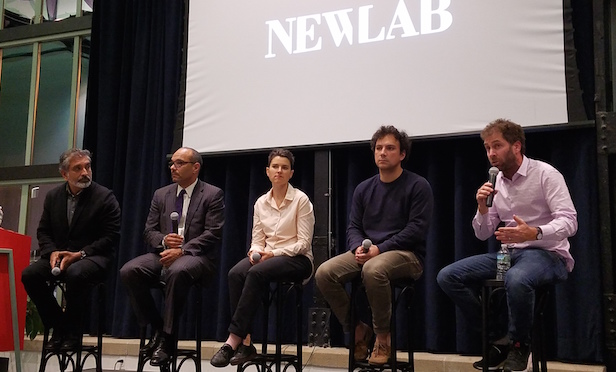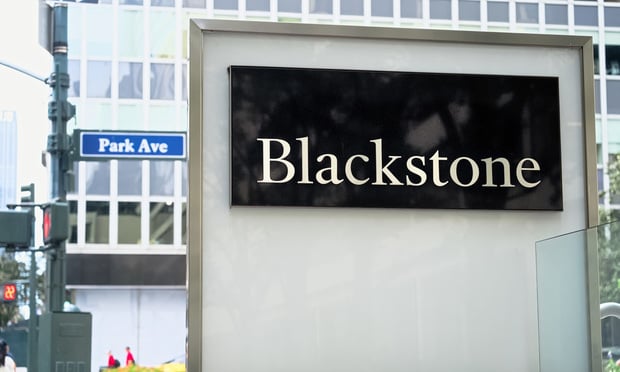
NEW YORK CITY— A prototype of the proposed Brooklyn Queens Connector (BQX), a streetcar that would run between Astoria, Queens and Sunset Park, Brooklyn was unveiled on Monday evening at the Brooklyn Navy Yard. Michael Rudin, senior vice president at Rudin Management Company, and Friends of BQX , board of directors member, welcomed the guests.
The proposed light rail system is anticipated to cost approximately $2.5 billion. The Association for a Better New York, Friends of BQX and Tech:NY hosted a panel discussion, “Beyond Amazon.” In reference to the city's bid to be the internet retailer's second home, the talk focused on ways to make New York City its most competitive in attracting companies and talented people. As transportation was a key point, the event concluded with a tour of the model rail car.
Panelist Jed Walentas, CEO of Two Trees Management, founded the Friends of the BQX, and serves as its executive committee chair. He explained the BQX would be funded through a mechanism called value capture. This involves increases in property tax of the real estate located near the rail line, which benefits from the streetcar's operations. The taxation would generate the revenue to pay the debt that funded the initial investment.
The streetcar project has not been without its controversies, including this Daily News report on contributions to Mayor Bill de Blasio from real estate developers who stood to gain by the mayor's approval of the BQX. The mayor vehemently denied such allegations.

“The reality is every time the public makes an investment in a community, whether it's a park, an improvement of a school or a piece of transit, the real estate owners are the ones who benefit,” said Walentas. “We need a system for these real estate owners to give back more than they are now and to figure out a way to use that value to finance these kinds of pubic goods.”
Two Trees owns several properties along the waterfront, close to where the BQX would run. The Walentas family business is well know for its investments in Brooklyn, particularly having influenced the shape and character of Dumbo.
Dani Simons, the vice president for strategic communications at Regional Planning Association, said rezoning and redevelopments can also raise money from developers. She cited the Midtown East rezoning which in addition to increasing tax revenue also requires developer funding for subway infrastructure improvements.
“Zoning is a way to pay for things,” said Walentas. “You are creating value out of thin air to create a public resource.”
The moderator, Vishaan Chakrabarti, also on the board of directors of the Friends of the BQX, is an architect and the founder of Practice for Architecture and Urbanism. He added with a smile, “I used to tell my students the only way to legally print money in the United States is the Federal Reserve and upzoning.”

In addition to transportation, the panelists cited affordability and equity as two other areas in which New York City needs improvement. “Whether you are low income or middle income, unless you are the top 1%, this is a tough place to live,” said Simons. In looking at ways to make the region more affordable, availability of housing and better transportation to the housing would allow people to work in wider geographic regions.
Panelist Bishop Mitchell G. Taylor who grew up in Queensbridge appreciates transportation that would not require going to Manhattan to travel between boroughs. As the co-founder and CEO at Urban Upbound, Taylor sees alternative transportation for people who do not live close to subway lines, including waterways, light rails and Citibikes, as increasing the opportunity to move from poverty to prosperity. In addition, according to Simons, most of the job growth she has observed is occurring outside of Manhattan's central business district.
Panelist Serkan Piantino is the founder and CEO of Spell. Previously, he worked at Facebook where he led the development of products including the News Feed, Timeline and Messenger. He appreciates that New York is not a one industry town—and not just tech.
“You get to interact with people of all walks of life,” says Piantino. “Diversity really is the genuine reason why people prefer New York to other places to start a company. People come here with more curiosity about what's going on around them than they do in other places.”
At the Brooklyn Navy Yard, last week Mayor Bill de Blasio celebrated opening one of the largest manufacturing spaces in decades, Building 77. The $185 million renovation of the WWII -era storage facility, a one million square-foot, state-of-the-art manufacturing structure, is a milestone in the mayor's plan to create 100,000 good paying jobs across a range of industries.
At the Building 77 opening, the Brooklyn Navy Yard also launched its search for a tenant to transform the rooftop space into creative uses. The 24,000 square-foot space on the 16th floor includes approximately 8,011 square-feet of interior space and 16,456 square feet on the adjacent outdoor roof.
Want to continue reading?
Become a Free ALM Digital Reader.
Once you are an ALM Digital Member, you’ll receive:
- Breaking commercial real estate news and analysis, on-site and via our newsletters and custom alerts
- Educational webcasts, white papers, and ebooks from industry thought leaders
- Critical coverage of the property casualty insurance and financial advisory markets on our other ALM sites, PropertyCasualty360 and ThinkAdvisor
Already have an account? Sign In Now
*May exclude premium content© 2025 ALM Global, LLC, All Rights Reserved. Request academic re-use from www.copyright.com. All other uses, submit a request to [email protected]. For more information visit Asset & Logo Licensing.








